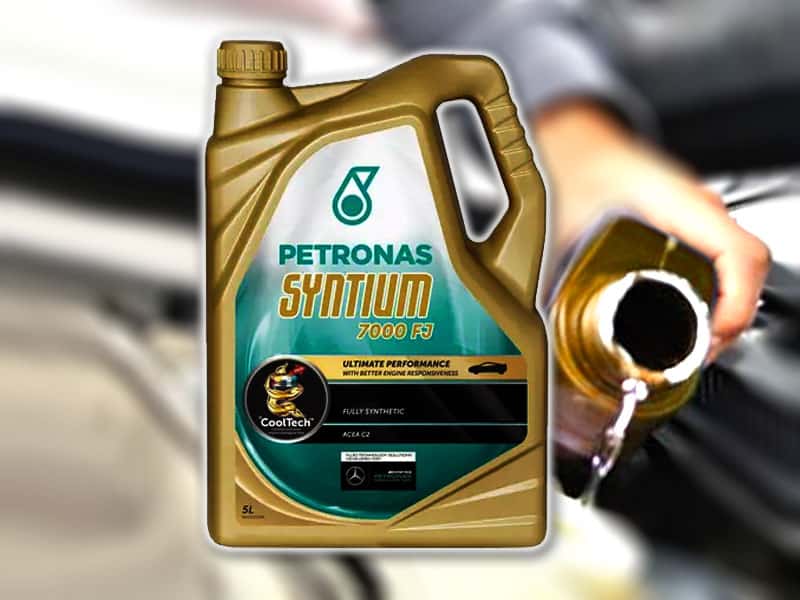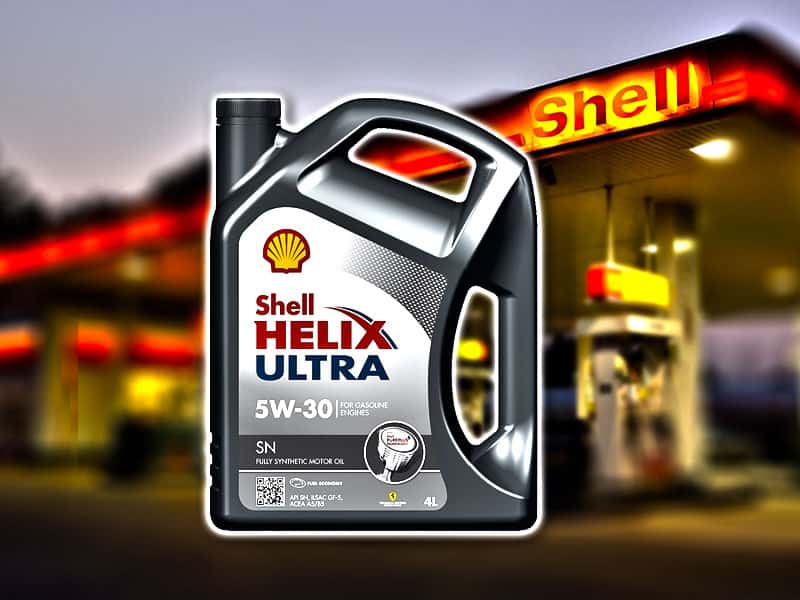Both oils are entirely synthetic, developed to utilize in both gasoline and diesel engines. Shell Helix Ultra is formed from Pure Plus Technology which mainly focuses on providing engine cleanliness while Petronas Syntium 7000 pays more attention towards protection against engine wearing and degradation.
Shell Helix Ultra provides high catalytic converter performances due to its lower ZDDP compounds concentrations.

It is very effective in removing the sludge from the engine thus providing its smoother working. Lower concentrations of lighter molecules allow the oil to achieve its flashpoint at a higher temperature, protecting it from pre-mature burning.
It also provides a very commendable performance at extremely low and high temperatures.
A higher TBN allows the oil to have longer oil change durations.
Compare Shell Helix Ultra with others:
Syntium has greater quantities of anti-wearing additives to allow better protection against engine wear and tear. Detergents are present in nominal amounts to allow shielding against sludge build-ups.
High kinematic viscosities allow the oil to perform decently at exaggerated temperatures.
The low cost makes it one of the most budget-friendly and economical engine oil.
| Specifications | Shell Helix Ultra (0W-20) | Petronas Syntium (0W-20) |
| Oil Type | Fully Synthetic | Fully Synthetic |
| Engine Type | Gasoline/ Diesel | Gasoline / Diesel |
| Available viscosity grades | 0W-30, 0W-40, 5W-20, 5W-30, 5W-40, 10W-60 | 0W-16, 0W-20, 0W-30, 0W-40 |
| ILSAC | GF-5 | GF-5 |
| API | SN | SN |
| Oil change frequency (Km) | 10,000 | 7000-8000 |
| Additives | Anti-wear, Detergents, Dispersants, Anti-foam agents | Anti-oxidants, Viscosity modifiers, Detergents, Dispersants, Anti-wears |
| ACEA | A1/B1 | A3/B4 |
Table of Contents
Comparison of Engine Wear-off Protection
Special additives are added to the oil known as anti-wear, to minimize friction problems.
These additives form a thin lubricating film all over the moving parts of the engine to restrict them from skidding over one another.
The presence of these additives in greater quantities enables it to form a more resistant layer providing high lubrication.
Ultra, in comparison, contains a lower proportion of these anti-wearing additives.
That’s why it is relatively less effective in protecting engine wear and tear.
Syntium, due to its higher concentrations of zinc and phosphorus-based anti-wear additives, allows it to form a more solid layer around the metal parts of the engine.

Therefore, its performance in terms of wearing resistance is better in comparison to its counterpart.
Viscosity Comparison
The internal hindrance to the flow of a fluid is called kinematic viscosity.
The oil which possesses high kinematic viscosity will perform better at elevated temperatures.
The difference in the fluid viscosity when the temperature switch from normal to high is commonly referred to viscosity index.
This viscosity index is needed to be high for oil to experience low viscosity variations. Pour point is the minimum temperature lower than which fluid is unable to flow under the influence of gravity.
The performance of Shell Ultra is better at both medium (40 o C) and high temperatures (100 o C) due to its relatively high kinematic viscosity at these particular temperatures.

It also has a greater viscosity index allowing lower variation in kinematic viscosity between temperature changes.
The oil also provides better cold startups because of its lower pour point temperature.
| Contrasting oils (0W-20 Grade oils) | KV at (40 o C)(cSt) | KV at (100 o C) (cSt) | Viscosity index (VI) | Pour point (o C) |
| Shell Helix Ultra | 46.30 | 8.80 | 172 | -48 |
| Petronas Syntium 7000 | 45 | 8.4 | 167 | -40 |
Comparing catalytic converter working
The ignition of the oil forms zinc and phosphorus ash. This ash, which is toxic in nature, enters into catalytic converter and blocks it.
The blockage further leads to improper functioning of the converter, making it less reliable.
Upon testing, it is revealed that the concentrations of ZDDP compounds in Ultra are lower so it produces less ash, making it more catalytic converter friendly.
Syntium contains greater amounts of these anti-wearing compounds (zinc and phosphorus). This results in the production of more ash which goes into the catalytic converter causing hindrance in its working.
Comparing reduction of sludge formation
The reaction of debris like dust or moisture with the oxidized oil makes a thick black viscous fluid known as sludge.
This sludge build-up is extremely dangerous for the proper functioning of the engine as it blocks oil movements inside it.
Detergents along with dispersants are included in the oil to lower this issue.
Shell Helix Ultra has higher amounts of both calcium and magnesium-based detergents to minimize sludge formation. It also contains more anti-foaming agents to lower the foaming issue.
Overall, it is better in terms of protection against sludge.
The quantities of these detergents are relatively lower in Syntium.
Also, it has a higher foam build-up problem because of its lower possession of anti-foaming additives causing it to be behind its competitor.
Comparing oil early burning protection
The volatility of the oil depends on the number of lighter molecules.
At elevated temperatures, these molecules won’t be able to withstand and vaporize rapidly.
The presence of these molecules in higher amounts makes the oil more volatile, resulting in lower protection against early oil ignition.
Shell Helix Ultra provides better protection against early oil burn-off due to its lower concentrations of lightweight molecules, enabling oil to reach its flashpoint at relatively much high temperature.
The number of lighter molecules in Syntium is higher.
It causes the oil to have a comparatively lower flashpoint temperature, making oil more volatile and lower shielding against pre-oil burning.
| Contrasting Oils (0W-20 Grade oils) | Flashpoint (o C) |
| Shell Helix Ultra | 224 |
| Petronas Syntium 7000 | 200 |
Comparison of oil changing frequency
The oil changing frequency of the oil depends on various factors including Total Base Number (TBN).
Alkaline additives are added to the oil to nullify the acid formation during the combustion process of oil.
TBN measures the concentration of bases in the oil.
Over the passage of time, the TBN value of the oil starts to decrease. So, the oil with higher TBN is more preferred as it provides longer oil changing intervals.
The higher TBN of Shell Helix Ultra helps it to provide a longer oil changing duration, after covering a distance of 10,000 km.
Meanwhile, Syntium provides a shorter duration due to its lower TBN. It is needed to be changed after an average distance of 7,000 to 8,000 km.
Quick Summary
- Both the oils are fully synthetic used for gasoline as well as in diesel engines.
- Ultra has lower concentrations of ZDDP compounds, making the catalytic converter more efficient due to less ash formation.
- Ultra is more effective in cleaning the sludge due to the presence of more detergents.
- Syntium contains a greater number of lighter molecules which makes it more volatile and less impactful in protecting against pre-oil burn-off.
- Due to greater amounts of anti-wear additives in Syntium its resistance against wearing and engine degradation is better.
- Ultra’s performance at elevated temperatures is better because of its high kinematic viscosities at medium and high temperatures.
- The working of Ultra is better in cold and chilly conditions.
- Syntium has a lower oil changing frequency due to its lower TBN.
- Ultra is more expensive, simply because of its high fuel economy.